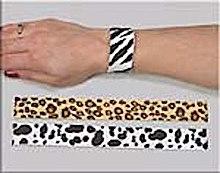A slap bracelet (or snap bracelet) is a bracelet consisting of layered, flexible stainless steel bistable spring bands sealed within a fabric, silicone, or plastic cover. It can have many different colours and/or designs.
History
The slap bracelet was invented by Wisconsin teacher Stuart Anders and sold under the brand name "Slap Wrap".
Original Slap Wrap slap bracelets had been 23 cm (9 inches) in length, 2.5 cm (1 inch) wide, and made of steel that was 0.15 mm (0.006 inch) thick; although, cheap knock off versions had used thinner steel, which was more likely to break and/or cut the wearer, the dangers of which first came to light in 1990, soon after they were released.[1]
It was a popular fad among children, pre-teens, and teenagers in the late 1980s. It was available in a wide variety of patterns and colors. The bracelet was banned in several schools following reports of injuries from worn out or modified versions.[2][3]
References
- ^ Ramirez, Anthony (October 27, 1990). "Turning Profits Hand Over Wrist". The New York Times.
- ^ "U.S. Consumer Panel Warns of Injury by 'Slap' Bracelets". The New York Times. Associated Press. October 30, 1990.
- ^ "Principal Puts a Halt to Slap-Bracelet Fad". The New York Times. Associated Press. October 11, 1990.
